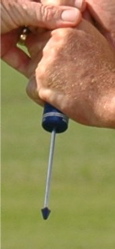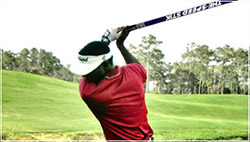As I continue with building my off-season plan, I have been looking at various training aids that I can use during the winter months to help me build a more consistent, repeatable swing. I also figure I’ll be able to get off to a fast start once the snow melts.
As with the rest of the golf equipment industry, training aids have exploded over the last few years and it was a bit maddening to sift through all the various kinds and styles. It seems as if everyone has an idea that will help you correct your slice, find the “slot,” or help you gain twenty yards. After spending a few months looking over the multitude of options, I think I found a few that will help me accomplish my goals.
Leadbetter’s Swingsetter
 One of the first aids I looked at was the Swingsetter which was designed by David Leadbetter. I first found out about this training aid after reading through our review. What intrigued me the most about the Swingsetter was it seemed to be an all in one aid focusing on grip, tempo, swing plane and release.
One of the first aids I looked at was the Swingsetter which was designed by David Leadbetter. I first found out about this training aid after reading through our review. What intrigued me the most about the Swingsetter was it seemed to be an all in one aid focusing on grip, tempo, swing plane and release.
Being able to identify a problem with your swing and knowing how to correct it is something with which I have struggled. I would have difficulty in identifying the one part that was causing my swing to break down. Not knowing what was wrong would lead to more frustration with my golf game and the frustration would only get worse by reading through all the various tips in the latest golf magazine and trying to find a solution. What was worse was hitting a good shot and wondering how the heck did I just do that. The Swingsetter seemed to be an aid that would not only help me diagnose a problem when it occurred but would also provide a remedy to fix it as well.
As tempting as it was, I decided not to go with the Swingsetter as the price was a bit much. For approximately the same amount of money, I can get two lessons from my PGA pro which I felt would me more beneficial to my overall development as I could use one lesson to work on my full swing and still have another lesson to work on the short game, putting, or as a follow-up to the first lesson.
Weighted Clubs
 Using a weighted club or training aid was another option I looked at to help better ingrain muscle memory as well as provide the added benefit of increasing my swing speed which would give me a few extra yards. One weighted aid I looked at was the Speed Stik which is endorsed by Vijay Singh. I swung it a few times and while it seemed neat to see your swing speed and was easy to use, I didn’t feel I received any more of a benefit compared to using my old Taylor Made Bubble Burner driver that I had re-shafted with steel and just slapped on a weighted donut. Twenty bucks for the re-shaft and weight donut seemed to be a better investment. I usually will make a few swings a week during the off-season and then use it as part of my warm up when I practice at the range.
Using a weighted club or training aid was another option I looked at to help better ingrain muscle memory as well as provide the added benefit of increasing my swing speed which would give me a few extra yards. One weighted aid I looked at was the Speed Stik which is endorsed by Vijay Singh. I swung it a few times and while it seemed neat to see your swing speed and was easy to use, I didn’t feel I received any more of a benefit compared to using my old Taylor Made Bubble Burner driver that I had re-shafted with steel and just slapped on a weighted donut. Twenty bucks for the re-shaft and weight donut seemed to be a better investment. I usually will make a few swings a week during the off-season and then use it as part of my warm up when I practice at the range.
Tough Clubs
Another training idea (hat tip to our Editor in Chief, Erik, for this) is to get some clubs that are tougher to hit than you’re current set and practice with those to ingrain muscle memory as well as to provide better feedback when hitting a ball rather than practicing with your current clubs over the winter. You are simply forced to make good swings and not get sloppy or your hands will pay the price.
For me, this turned out to be one of the best aids I have used as my current set of irons are over-sized cavity backs that provide very little feedback. Nothing against these clubs, but they provide little feedback when you hit a ball, so I don’t know exactly where the ball was struck on the club face. Using tougher, smaller-headed irons, I know when I mis-hit a ball as my stinging hands can greatly attest to. I can feel subtle differences between shots hit thin, towards the toe, or on the sweet spot.
This was one of the least expensive avenues as I was able to score a complete set of irons from a used club retailer that was going out of business for $70 that had a smaller club head than my current set. I’ve only used them a few times, but I can already feel improvement in my ball striking as I can’t get sloppy with my swing. Plus, I now have an additional set in which I can test out different golf grips as well as gain additional experience in replacing them as well. Also, I can beat these up on the practice mats at the golf domes, indoor ranges and simulators without worrying to much about damage to my game irons.
Conclusion
There can be an overwhelming feeling when looking at various training aids that one can use over your off-season. The market is flooded with products that claim to help you gain ten yards, correct your slice and put your swing on the right plane. I spent a few months doing research and finding out from lower handicap golfers as to what they recommend and what has worked (and not worked) for their golf games and while the above list is by no means exhaustive, I found that sometimes what I already have was good enough. Spending a little time to build your swing rather than looking for a quick fix can lead to a much better golfing experience as I have found out over the winter. Now, if only the snow would melt.
Being from the same neck of the woods as Allen, I struggle with the same off-season challenges. I’ve had success this off-season with one of the more common weighted clubs you’ll out there for sale as well as focusing stretching to increase range of motion. The only knock I’ve got on the club is the training grip that I’ve been too lazy to have regripped. I’ve measured my improvement based on results at a golf dome here locally and have noticed improvements in consistency.
I think training aids are no different than golf clubs, different ones work for different people, some don’t work for anyone, but there certainly isn’t one that works for all.
-Mike
One of the best, and cheapest, training aids I have used during the off-season is a 2 pound dumbell. Grip it like a club, swing back slowly and stretch to a full extension and allow the weight to drop your hands down into the hitting zone. Do it slowly, pay attention to where your hands are and let the release happen naturally. It’s great, easy to do and really helps with tempo.
Cheers,
Ger63
In my experience, the best bit of winter training you can do is find a small patch of grass, clear it of snow, and chip to a target from 30 yards and in. You’ll hit the course in the spring with a killer short game that will get you out of trouble when you hit the course with a little winter rust.
Also, hitting on matts at a range during the winter could potentially put your golf game back by months when the spring comes around and you hit off the turf again. A matt can be very forgiving for an average player; the club bounces of it and an unsuspecting player could be hitting the ball heavy all winter without even realising it! Then they hit off the grass and they get the shock of their lives! Just be very careful.
There are only two I use and by far the easiest and most cost effective one for me is an old broken shaft. Stuck in the ground next to me (ala Vijay) it helps keep my swing more upright. My most common slip seems to be when I let my swing get to flat.
http://www.proplayfittingsystems.com/
I’ve just discovered this. Not really a training aid, but I thought they worked great.
I’m a right handed golfer. I wear my watch on my left wrist. A ruler, pencil or long tee under the strap pointing toward, and over, my wrist joint prevents the wrist extending at the top of the backswing (leading to an open clubface). It keeps my wrist firm and directly in line with my forearm, squaring the face at the top. Square clubface means straighter shots.
You can buy a glove with a plastic insert for about £30 ($40) but an old pencil or a long tee is super cheap and super effective.